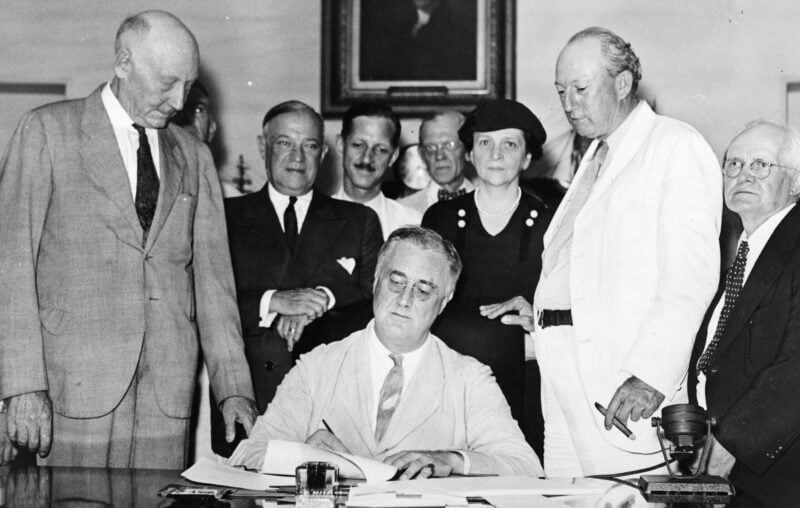

Donald Trump and Joe Biden started the marketing campaign season by staying away from social safety reform. Kamala Harris has solely promised to strengthen it with out offering particulars. Mr. Trump then proposed a really unhealthy thought and has refused to again down. That concept is the elimination of revenue taxes on social safety advantages.
The richest retirees obtain essentially the most Social Safety and thereby put essentially the most stress on an already unsustainable funds. Eliminating the revenue tax on advantages will lead to them getting much more after-tax revenue, whereas considerably lowering revenue tax income at a time when it solely takes our nation 260 days to tack on one other trillion to the nationwide debt.
The Social Safety program was too weak to demographic bubbles from the very starting and subsequent reforms have more and more over-promised advantages thereby inviting our current funds insolvency. Voters are pissed off and shedding confidence. They’re in search of real management, not the “third rail of politics” coverage détente we now have.
Harris and Trump now have a chance to supply such management. Every might promise to do one fast and easy factor as president to cut back the unfunded legal responsibility hole in Social Safety funding. It’s straightforward to clarify to voters, it’s going to attraction to each youthful and older voters, and it’ll particularly attraction to these within the political center who’re in search of sensible options relatively than ideologically pushed bumper sticker slogans. It might behoove each candidates to leap on this reform proposal first.
In 1972, an modification was handed to guard Social Safety beneficiaries from the consequences of inflation. A mistake was made within the process for implementing the Price of Dwelling Changes indexing of advantages. This had the impact of over-accounting for the consequences of inflation, resulting in the prospect of profit ranges hovering uncontrolled as inflation worsened within the 70s. In 1976, a Congressional panel led by a Harvard economist, William Hsiao, was convened partly to right the error. The panel additionally advisable that the preliminary advantages calculation make use of value indexing relatively than wage indexing out of worry that the latter would produce an unsustainable funds. Sadly, wage indexing was chosen over value indexing.
This was a expensive mistake, and we’re nonetheless paying for it. As famous by Alex Durante in a current Tax Basis report,
Had value indexing [rather than wage indexing] been carried out beneath Hsiao’s proposal, Social Safety would have run surpluses yearly from 1982 to 2023, aside from 2021. There would have been momentary shortfalls beginning in 2024, however by 2044, Social Safety would have been operating surpluses once more. Surpluses in Social Safety might allow a discount within the tax price or permit a number of the income raised from payroll taxes to help Medicare, which can also be operating massive deficits.
Whereas this was a horrible missed alternative, the primary lesson remains to be legitimate: wage indexing makes advantages develop too quick for program stability. Fortunately, it isn’t too late to take Hsiao’s recommendation.
In accordance with the Social Safety Administration’s 2023 Trustee Report, adjusting the preliminary profit calculation with a value index relatively than a wage index will take away about 80 % of the unfunded legal responsibility hole over the following 75 years, and that’s if instituted in 2029. The outcomes are much more dramatic if we begin sooner. That’s main achieve with minimal ache.
Most voters don’t notice that social safety advantages have been, and proceed to be, rising in inflation-adjusted phrases as a result of wage indexing of the preliminary profit calculation. It is because when the financial system is rising, wages usually develop quicker than costs (that’s what produces rising actual private revenue over time). Because of this, since 1977, every new class of social safety recipients lives slightly bigger than those earlier than.
That is very silly.
Younger persons are understandably apprehensive about being cheated out of a few of their Social Safety advantages, and having the actual worth of the advantages they do obtain eroded by inflation. They don’t seem to be apprehensive about not getting extra from Social Safety once they retire in actual phrases than their dad and mom and grandparents did.
Most younger folks will fortunately help this reform as a result of it gives robust assurance that they’ll get one thing they worth tremendously (a reputable assure of not being impoverished in previous age) in return for giving one thing up they don’t care about (getting greater than their dad and mom and grandparents did per greenback contributed).
This straightforward reform won’t hurt present retirees in any means and can produce an amazing aid to those that are able to retire and are already uneasy about their 401Ks, in addition to youthful employees who’re merely in search of honest remedy.
The media and voters ought to power the candidates to clarify why they received’t pledge, now, to drop wage indexing to stabilize Social Safety going ahead.

